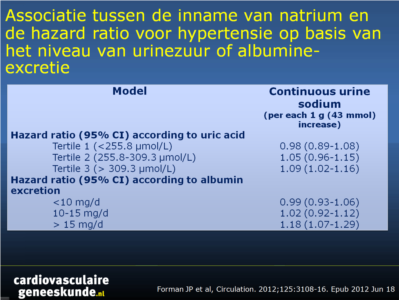Natriuminname: een risicofactor voor endotheeldisfunctie en hypertensie
Literatuur - LiteratuurAssociation between sodium intake and change in uric Acid, urine albumin excretion, and the risk of developing hypertension.
Forman JP, Scheven L, de Jong PE, Bakker SJ, Curhan GC, Gansevoort RT.
Circulation. 2012;125:3108-16. Epub 2012 Jun 18.
Achtergrond
Hoewel een kortdurende inname van een grotere hoeveelheid natrium de bloeddruk niet aanzienlijk verhoogt, [1,2], is een hoge inname van natrium gedurende langere tijd geassocieerd met verhoging van de bloeddruk na verloop van tijd bij gezonde mensen [3,4]. De redenen hiervoor zijn niet goed duidelijk. Korte natriumbelasting is geassocieerd met endotheeldisfunctie en vasculaire schade [4]. Op de lange termijn zou dit een verklaring kunnen zijn voor hypertensie geassocieerd met een chronische hoge zoutinname.Een verhoogd serum urinezuur (SUA) en een hogere urinaire albumine-excretie (UAE) zijn markers van endotheliale dysfunctie en onafhankelijk geassocieerd met een verhoogd risico van hypertensie.
Een hogere inname van natrium zou positief kunnen zijn geassocieerd met een longitudinale toename van de SUA en de UAE, wat het verband tussen de inname van natrium en hypertensie zou kunnen wijzigen. Dit werd getest in deelnemers aan de PREVEND-studie (Prevention of Renal and Vascular End Stage Disease).
Belangrijkste resultaten
- Een hogere natriuminname veroorzaakte een toename in de SUA en de UAE.
- De gecorrigeerde hazard ratio voor het ontwikkelen van hypertensie was 0,98 (95% CI, 0.89 tot +1.08) voor het laagste tertiel van SUA en 1,09 (1,02 tot 1.16) voor het hoogste tertiel voor elke 1g hogere inname van natrium.
- De gecorrigeerde hazard ratio voor het ontwikkelen van hypertensie was 0,99 (95% CI, 0,93-1,06) voor het laagste tertiel van UAE en 1,18 (95% CI 1.07 tot 1.29) voor het hoogste tertiel voor elke 1g hogere inname van natrium.

Conclusie
Een hoge inname van natrium gedurende een langere tijd kan leiden tot endotheeldisfunctie en vasculaire schade, wat kan resulteren in een verhoogd risico voor het ontwikkelen van hypertensie.
Referenties
1. Institutes of Medicine. A Population-Based Policy and Systems Change Approach to Prevent and Control Hypertension. http://www.iom.edu/ Reports/2010/A-Population-Based-Policy-and-Systems-Change-Approachto-Prevent-and-Control-Hypertension.aspx. Accessed July 2011.2. Carlstrom M, Sallstrom J, Skott O, et al. Uninephrectomy in young age or chronic salt loading causes salt-sensitive hypertension in adult rats. Hypertension. 2007;49:1342–1350.
3. Chien KL, Hsu HC, Chen PC, et al. Urinary sodium and potassium excretion and risk of hypertension in Chinese: report from a community-based cohort study in Taiwan. J Hypertens. 2008;26:1750 –1756.
4. He FJ, MacGregor GA. Effect of longer-term modest salt reduction on blood pressure. Cochrane Database Syst Rev. 2004:CD004937.
Abstract
Background:A high-sodium diet has little short-term effect on blood pressure in nonhypertensive individuals but, for unclear reasons, is associated with hypertension if consumed long term. We hypothesized that a chronically high sodium intake would be associated with increases in biomarkers of endothelial dysfunction, specifically serum uric acid (SUA) and urine albumin excretion (UAE), and that high sodium intake would be associated with incident hypertension among those with higher SUA and UAE.
Methods and results:
We prospectively analyzed the associations between sodium intake and the change in SUA (n=4062) and UAE (n=4146) among participants of the Prevention of Renal and Vascular End Stage Disease (PREVEND) study who were not taking antihypertensive medications. We also examined the association of sodium intake with the incidence of hypertension (n=5556) among nonhypertensive participants. After adjustment for confounders, each 1-g-higher sodium intake was associated with a 1.2-μmol/L increase in SUA (P=0.01) and a 4.6-mg/d increase in UAE (P<0.001). The relation between sodium intake and incident hypertension varied according to SUA and UAE. For each 1-g-higher sodium intake, the adjusted hazard ratio for developing hypertension was 0.98 (95% confidence interval, 0.89-1.08) among those in the lowest tertile of SUA and 1.09 (1.02-1.16) among those in the highest tertile. Corresponding hazard ratios were 0.99 (confidence interval, 0.93-1.06) among participants whose UAE was <10 mg/d and 1.18 (confidence interval, 1.07-1.29) among those whose UAE was >15 mg/d.
Conclusions:
Over time, higher sodium intake is associated with increases in SUA and UAE. Among individuals with higher SUA and urine UAE, a higher sodium intake is an independent risk factor for developing hypertension.

Deel deze pagina met collega's en vrienden: